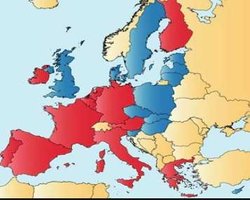The European Commission predicts gradual economic recovery with stubbornly high unemployment in several member states, what many are calling European jobless growth.
In its “Autumn 2013 Economic Forecast”, the European Commission says there have been promising signs that the European Union is undergoing an economic recovery.
The Commission wrote “After contracting up to the first quarter of 2013, the European economy started to grow again in the second quarter and real GDP is set to continue growing in the remainder of this year.”
During the second half of 2013, EU GDP is expected to grow 0.5% compared to the second six months of 2012.
The countries that use the euro as their currency – the euro area – will have negative growth for 2013, estimated to be minus 0.4%, while the European Union as a whole, including its members not in the euro area will see 0.0% GDP growth. In other words, non-euro area countries are generally doing better.
Growth will eventually increase to 1.4% in the EU (1.1% in euro area) next year, reaching 1.9% in EU and 1.7% in the euro area in 2015.
The Commission says that structural reforms and fiscal consolidation recently implemented have helped turn the economy round. The main engine of growth in Europe, domestic demand, has improved.
However, as circumstances have changed for the domestic economies, “the return to solid growth will be a gradual process.”
Commission Vice-President for Economic and Monetary Affairs and the Euro, Olli Rehn, said:
“There are increasing signs that the European economy has reached a turning point. The fiscal consolidation and structural reforms undertaken in Europe have created the basis for recovery. But it is too early to declare victory: unemployment remains at unacceptably high levels. That’s why we must continue working to modernize the European economy, for sustainable growth and job creation.”
European jobless growth, especially in the south
As the macroeconomic imbalances that had built up diminish, growth is expected to gradually pick up. However, the Commission warns that the “on-going balance-sheet adjustment in some countries continues to weigh on investment and consumption.”
Even though the financial market situation has got much better and interest rates have come down for countries with serious economic problems and high unemployment, this still needs to feed through to the real economy. There is still fragmentation in financial markets, with considerable differences across EU Member States and across firms of different sizes.
Over the next two years, domestic demand will be the main driver of growth, “against the background of a weakened outlook for EU exports to the rest of the world.”
Unemployment will remain high in many Member States, even though their economies are undergoing a recovery – the Commission explained. Developments in the labor markets generally lag those of GDP by at least 6 months.
In many Member States, including Spain, Greece, Portugal and Italy, unemployment has remained very high, even rising during most of this year.
The Commission estimates that unemployment will fall to 10.7% in the EU and 11.8% in the euro area by 2015. However, there will still be a significant difference in unemployment statistics between northern and southern Member States.
The US Treasury believes that European jobless growth is partly due to Germany’s enormous trade surplus and weak domestic demand.

